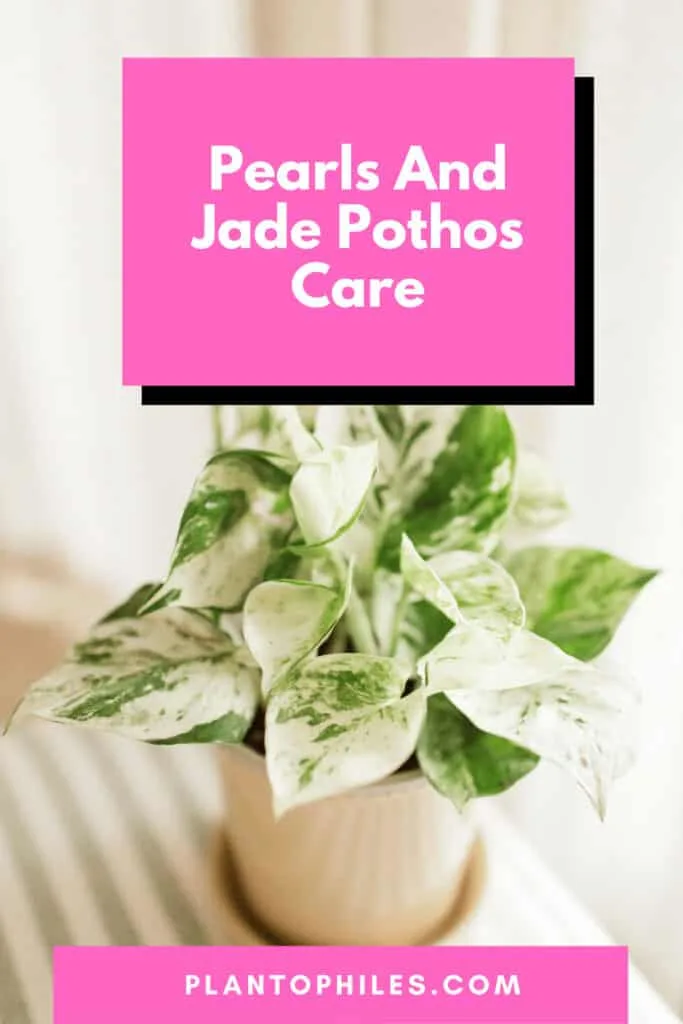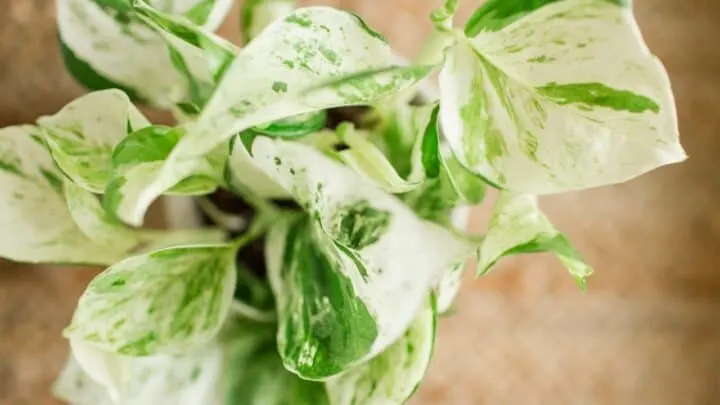If you want to learn how to care for Pearls and Jade Pothos, this article is for you. Epipremnum aureum ‘Pearls and Jade’ (scientific name) is a Pothos variety with cool white and green variegation.
Unsurprisingly, Pothos plants are some of the most revered species in the plant kingdom. Their enchanting trailing growth habit not only brightens up a room but also makes a bold statement.
Compared to other climbers, such as Hoyas and the string of pearls, Pothos are relatively easier to care for.
This is why I have several pothos species in my plant collection, with one of my favorites being the Pearls and Jade.
A slow grower, the Pearls and Jade is also easy to maintain.
Table of Contents
Pearls and Jade Pothos
Pearls and Jade Pothos belongs to the Epipremnum genus of flowering plants. It is part of the Araceae family of flowering plants according to Silver Crome Gardens. But Pothos flower rarely.
Native to the islands of French Polynesia, Pothos are known by their more popular name, the Devil’s ivy.
Pearls and Jade Pothos is a Pothos varietiy with variegated leaves. It sports white, gray, and green-colored foliage irregular patterns. Its leaves can reach up to 3 inches long and 1.5 to 2 inches wide.
To this day I have never seen any of my Pothos flowering. I also have never seen a flowering Pothos on the internet.
Pearls and Jade Pothos Care
To care for Pearls and Jade pothos water once a week on average. Allow the potting mix’s top 2 inches (5 cm) to dry before rewatering. Apply a well-balanced fertilizer during its growing season. Place your potted Pothos in a spot with bright, indirect sunlight. Keep the temperatures at 60 to 85°F (15 to 29°C), and the humidity should be no less than 70%. Prune occasionally to keep it compact and repot it once it becomes root-bound. Lastly, ensure you grow these Pothos in a rich, well-draining potting mixture.

Soil
Well-draining potting mix.
Is this your first time planting the Pearls and Jade pothos? Are you worried about messing up the growing medium? You don’t have to. This plant adapts pretty well to any potting mix it’s planted in. As long as it’s rich in nutrients, drains well, and has good aeration.
In that regard, typical garden soil isn’t a good option for this plant. It’s too dense, yet Pearls and Jade Pothos require loosely compacted soil.
A potting mixture allows the free flow of nutrients, air, and water, which translates to a healthy root system.
So, while it might seem like an extra cost, consider investing in a potting mix. It should be formulated for succulents and Cacti like this one.
Often, you’ll find that the primary ingredient in a cacti mix is peat moss. This compound helps with absorbency and its ability to release moisture as needed.
Other ingredients you’re likely to find in a Cacti-specific potting mixture entail perlite or pumice and sand. Their purpose is to improve the soil’s drainage and aeration.
Pearls and Jade Pothos Light Requirements
Place your Pearls and Jade in a spot exposed to bright, indirect light for the best variegation. The light found in a northern or partially shaded eastern window is ideal.
A southern or western exposure can work, too, but you’ll have to place your plant a little further from the window. And if you notice your window letting in too much sunlight, consider adding a sheer curtain.
Otherwise, place it indoors, then provide it with fluorescent lighting.
Pearls and Jade Pothos Watering
Water Pearls and Jade Pothos once a week. Water again once the soil’s top 2 inches (5 cm) dry up.
Pearls and Jade Pothos prefer their potting mixture to remain slightly moist when watering.
Pothos plants are highly susceptible to root rot, and the main cause of this is waterlogged soil.
When you forget to water, its root system undergoes even more stress because it exerts too much effort to draw moisture from the soil.
The result? Yellow leaves, along with a couple of brown, crispy spots. The good news is that an underwatered pothos is easy to restore. Simply increase the frequency and amount of water to revive your plant.
Temperature
The ideal temperature for Pearls and Jade Pothos is between 60 and 85°F (15 to 29°C).
In winter, look for ways to keep your Pothos warm. Ensure the temperature never drops below 50°F (10°C).
In very cold temperatures, the plant’s cells freeze, damaging and interrupting the pathways for nutrients and water.
One thing I have learned is the essence of nourishing my Pearls and Jade before winter sets in. This way, it has a food supply stock and doesn’t enter this cold season under drought stress.
If some of the plant’s parts aren’t receiving enough food and water, the vines will become weak while the leaves start to discolor and wither.
Humidity
The ideal humidity is between 50-70%. Although the Pearls and Jade pothos can tolerate dry air, they thrive in high humidity. It is a tropical plant after all.
So how do you know whether your pothos is happy with the present moisture levels? Well, check the coloration on its leaves. If the leaf tips turn brown, the air is too dry.
But also ensure plant leaves do not remain wet. Pothos is vulnerable to a fungal disease called Rhizoctonia blight. It’s caused by factors such as:
- Frequent misting
- Very close spacing of plants
- Insufficient airflow
- Wet leaves or stems
To err on the side of caution, I prefer to relocate my Pearls and Jade pothos to a spot with a higher humidity level (such as the bathroom) instead of misting.
If this doesn’t help, I create a pebble tray humidifier. To achieve this, look for a low-profile tray, arrange small stones on it, and then fill it halfway with water.
Next, take your Pothos pot and set it on the tray, ensuring that its roots don’t come into direct contact with water. Water will start evaporating from the tray, creating a humid environment around your plant.
Fertilizer
Pothos is not a heavy feeder and needs little fertilizer. Fertilize it every 2-months using a well-balanced fertilizer in spring and summer.
If you’re using a potting mixture that is already chock-full of nutrients, there’s no need to add fertilizer.
I prefer to add a bit of well-balanced or all-purpose fertilizer, then dilute it to half-strength before applying. Feed your pothos during the growing season in spring and summer only.
In winter, cut back or do away with feeding completely. Most plants enter dormancy in autumn and winter.
Too much fertlizer results in an accumulation of salts and minerals. This can scorch the roots and leaves of your plant.
Pearls and Jade Plant Propagation
The best propagation method for Pearls and Jade Pothos are stem cuttings.
The first step to propagating this plant is to cut a section off from the parent plant. Your stem cutting ought to be 4 to 6 inches long and have a couple of leaves on it, a minimum of 4 leaves.
Place your stem cutting in water for about two weeks. When placing your cutting in the water, submerge it 1 inch above the node. Then, give it ample time to root before transferring it to a soil medium.
Plant your cutting directly in a suitable potting mixture if you don’t want to propagate in water. In this case, bury the stem to a point just slightly above the node. It should start developing roots in the next two weeks.
Growth
Pearls and Jade grow slowly but can grow up to 30 feet in height (9 m). But it could be years before this happens. If your Pothos grows unruly indoors, cut it back and replant the cuttings to make your indoor plant bushier.
Potting
Pothos does not have to be repotted very often. Wait 2-3 years before transferring it to a new pot and fresh potting mix.
Only choose a pot 1-2 sizes larger. If the container is too big, it retains excess water, encouraging root rot.
Common Problems with Pearls and Jade Pothos
Pearls and Jade Pothos Pests
At times, your Pearls and Jade may come under attack from pests. The most common culprits are:
- Scale
- Mealybugs
- Aphids
- Thrips
- Spider mites
The majority of these pests damage your plant by sucking sap. The good news is that they’re fairly easy to control. I like to use insecticidal soap and Neem oil to control these insects.
It’s effective and eliminates the health risks arising from using chemical pesticides.
However, you’re free to try out other pest management techniques, such as:
- Pruning the damaged plant
- Throwing away or composting the plant
- Beneficial nematodes
- Systemic insecticide
FAQ
How can I improve the variegation on my Pearls and Jade pothos?
The variegation on this plant is a key characteristic and one that makes it a true work of art in the plant kingdom.
However, it can only exist under certain conditions. If these aspects aren’t maintained, your pothos could very well revert to having completely green leaves. To avoid this, ensure you:
- Always keep your plant potted- this makes it easy to move it around in case you need to transfer it to meet its lighting requirements.
- Expose your Pothos to bright indirect light- you must place this plant on a sunny spot to prevent it from losing its variegation.
- Keep the temperature consistent- Pearls and Jade is not the kind of plant that adapts well to sudden fluctuations in temperature. Any abrupt hot and cold temperature snaps can result in the plant losing its beautiful variegation.
How are Pearls and Jade pothos pruned?
If your pothos grows too big, your only option is to prune it. Well, not unless you plan to take it to an outdoor setting. So, how do you go about the pruning process?
For starters, decide just how far back you’d like to prune your houseplant. You can prune it as much as you want; up to 2 inches (5 cm) from the soil line. If you prefer to leave long vines intact, prune a little less.
Once you’ve decided, take each vine and establish the point where you’ll prune it. The ideal place to cut each vine is about ¼ an inch above each leaf.
The point where the leaf intersects with the vine is known as a node. From this area, a new vine will start growing after pruning.
Be careful not to leave some of the vines leafless. In my experience, such vines don’t regrow efficiently. You can prune it altogether if you end up with a leafless vine.
Repeat this process until you successfully prune every vine and are impressed by the outcome.
Wrap Up
Pearls and Jade Pothosis easy to care for. It develops dark green leaves variegated with hints of white and silver-gray. Plus, it’s a climbing and vining plant, which makes it perfect for hanging baskets and moss poles.

Daniel has been a plant enthusiast for over 20 years. He owns hundreds of houseplants and prepares for the chili growing seasons yearly with great anticipation. His favorite plants are plant species in the Araceae family, such as Monstera, Philodendron, and Anthurium. He also loves gardening and is growing hot peppers, tomatoes, and many more vegetables.


